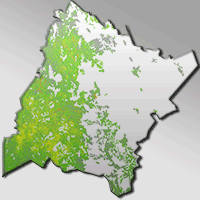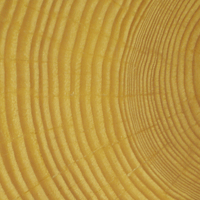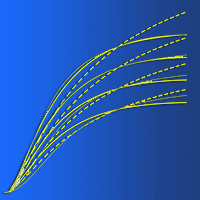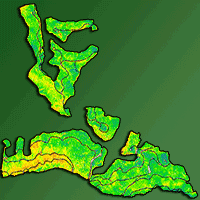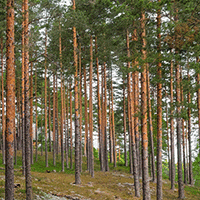
Diameter growth prediction for individual Pinus occidentalis Sw. trees
S Bueno-López (1) , E Bevilacqua (2)
iForest - Biogeosciences and Forestry, Volume 6, Issue 4, Pages 209-216 (2013)
doi: https://doi.org/10.3832/ifor0843-006
Published: May 27, 2013 - Copyright © 2013 SISEF
Research Articles
Abstract
Predictive equations calibrated with remeasurement data from 25 permanent plots having individually identified trees were used to project stem diameter of Pinus occidentalis Sw. in Dominican Republic. The general form of the models used to fit the growth and yield functions included fixed effect covariates related to three subsets of explanatory variables: initial tree size, stand attributes, and competition indexes. The subsets were incrementally added in a stepwise fashion for each of the three response variables and the intercept of the model was allowed to vary randomly between plots. The models evaluated included a yield function that predicted future diameter at year t (dt), a periodic annual increment model using five-year diameter increment (id5) and its natural log transformation [ln(id5+0.01)]. For trees that were not remeasured exactly 5 years after the first measurement, id5 was computed by averaging the mean annual increment nearest the 5 year point and multiplying by five. Each approach was evaluated using an independent validation data set based on seven goodness-of-fit statistics, graphical display of residuals and the variance components of each model combination. LMM, including fixed and random parameters, provided a better fit among the models tested. For estimating future diameter, accuracy of predictions is within one centimeter for a five-year projection interval, and bias is negligible. All the models had moderately improved fit statistics when random effects were included in the evaluation. The degree of improvement behaved in a similar manner for most fit statistics, with differences in the range of values for MSE, RMSE and RMSE% of 0.53, 0.23 and 1.05, respectively. The absolute difference between the extreme values for Bias and relative Bias (%) in all the models was 0.20 and 0.92. The differences in values for MAD were only 0.15 and R2 values were practically equivalent.
Keywords
Repeated Measurements, Mixed Models, Stepwise Regression, Site Quality, Individual Tree Competition Indexes
Authors’ Info
Authors’ address
Vicerrectoria de Investigaciones e Innovación, Pontificia Universidad Catolica Madre y Maestra, Santiago de los Caballeros (Dominican Republic)
College of Environmental Science and Forestry, State University of New York, 1 Forestry Drive, 13210 Syracuse, NY (USA)
Corresponding author
Paper Info
Citation
Bueno-López S, Bevilacqua E (2013). Diameter growth prediction for individual Pinus occidentalis Sw. trees. iForest 6: 209-216. - doi: 10.3832/ifor0843-006
Academic Editor
Marco Borghetti
Paper history
Received: Oct 26, 2012
Accepted: Mar 06, 2013
First online: May 27, 2013
Publication Date: Aug 01, 2013
Publication Time: 2.73 months
Copyright Information
© SISEF - The Italian Society of Silviculture and Forest Ecology 2013
Open Access
This article is distributed under the terms of the Creative Commons Attribution-Non Commercial 4.0 International (https://creativecommons.org/licenses/by-nc/4.0/), which permits unrestricted use, distribution, and reproduction in any medium, provided you give appropriate credit to the original author(s) and the source, provide a link to the Creative Commons license, and indicate if changes were made.
Web Metrics
Breakdown by View Type
Article Usage
Total Article Views: 73027
(from publication date up to now)
Breakdown by View Type
HTML Page Views: 63103
Abstract Page Views: 3514
PDF Downloads: 4984
Citation/Reference Downloads: 24
XML Downloads: 1402
Web Metrics
Days since publication: 4603
Overall contacts: 73027
Avg. contacts per week: 111.06
Citation Metrics
Article Citations
Article citations are based on data periodically collected from the Clarivate Web of Science web site
(last update: Mar 2025)
Total number of cites (since 2013): 6
Average cites per year: 0.46
Publication Metrics
by Dimensions ©
Articles citing this article
List of the papers citing this article based on CrossRef Cited-by.
References
Growth responses in individual eastern white pine (Pinus strobus L) trees following partial cutting treatments. PhD Dissertation, University of Toronto, Ontario, Canada, pp. 137.
Gscholar
Understanding growth and yield of Pinus occidentalis Sw. in La Sierra, Dominican Republic. PhD Dissertation, College of Environmental Science and Forestry, State University of New York, Syracuse, NY, USA, pp. 266.
Gscholar
Investigación y manejo de especies maderables de uso comun en La Sierra: guía técnica. San José de las Matas, Plan Sierra Inc., Republica Dominicana, pp. 269. [in Spanish]
Gscholar
A field guide to the pines of Mexico and Central America. The Royal Botanic Gardens, Kew, UK.
Gscholar
Applied longitudinal analysis. Wiley-Interscience, John Wiley & Sons, Inc., New Jersey, USA, pp. 536.
Gscholar
Using statistical models to study temporal dynamics of animal-landscape relations. In: “Temporal Dimensions of Landscape Ecology: Wildlife Responses to Variable Resources” (Bissonette JA, Storch I eds). Spinger-Verlag, New York, USA.
Gscholar
Ecología basada en zonas de vida. Instituto Interamericano de Cooperación para la Agricultura, San José, Costa Rica.
Gscholar
SAS system for mixed models. SAS Institute Inc., Cary, NC, USA, pp. 633.
Gscholar
A hierarchical model for tree height prediction. In: Proceedings of the “2003 Meeting of the American Statistical Association, Section on Statistics and the Environment”. San Francisco (CA - USA) 3-7 August 2003. The American Statistical Association, Alexandria, VA, USA, pp. 2865-2869.
Gscholar
The competition process in forest stands. In: “Attributes of trees as crop plants”. Titus Wilson & Son Ltd, Kendal, Cumbria, UK, pp. 592.
Gscholar
Perfecting a stand-density index for even aged forest. Journal of Agricultural Research 46: 627-638.
Gscholar
SAS/STAT User’s guide. SAS Institute Inc., Cary, North Carolina. pp. 213.
Gscholar
Plan maestro sector forestal. Informe principal. Plan Sierra Inc., San José de las Matas, Santiago, Dominican Republic, pp. 82.
Gscholar
Modeling forest growth and yield: Applications to Mixed Tropical Forests, CAB International, Wallingford, CT, USA, pp. 312.
Gscholar
Simulation of diameter growth and mortality in regrowth eucalypt forest of Southern Tasmania. Forest Science 27: 603-616.
Gscholar
A basal area increment model for individual conifers in the northern Rocky Mountains. Forest Science 36: 1077-1104.
Gscholar
Spatial assessment of model errors from four regression techniques. Forest Science 51 (4): 334-346.
Gscholar

